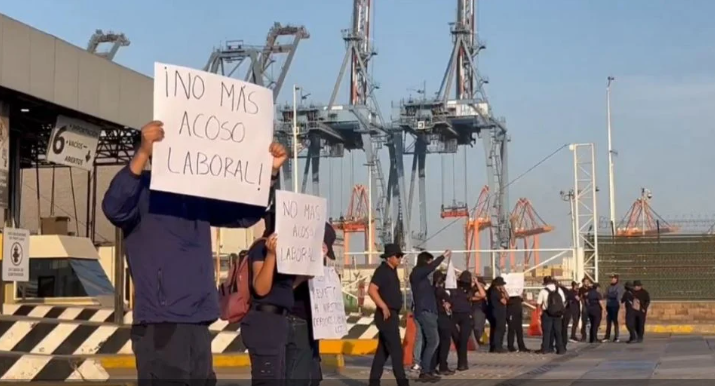Customs Clearance Crisis! Labor Protests Erupt at Mexico's Port of Manzanillo 通关危机!墨西哥曼萨尼约港爆发劳工抗议
Customs Clearance Crisis! Labor Protests Erupt at Mexico's Port of Manzanillo
通关危机!墨西哥曼萨尼约港爆发劳工抗议

图源网络
At 6:00 a.m. local time on May 12, a large-scale labor protest broke out at Mexico's Manzanillo Port. Hundreds of customs operations and administrative staff launched an indefinite strike to protest against long-standing labor rights violations. This action has caused a complete paralysis of land freight in the southern area of the port and has impacted the supply chains of many international businesses.
当地时间5月12日凌晨6时,墨西哥曼萨尼约港爆发大规模劳工抗议。数百名海关操作及行政人员启动无限期罢工,抗议长期存在的劳动权益侵害问题,导致港口南部区域陆路货运全面瘫痪,多国企业物流链遭受冲击。
According to on-site videos, striking workers blocked the southern entrance and exit channels of the port, holding up signs such as "Stop workplace bullying" and "Reject overtime work." Union representatives highlighted three core demands to the media:
- Systemic workplace bullying has long existed.
- Compulsory 16-hour workdays without rest.
- Salary arrears remain unresolved.
据现场视频显示,罢工人员封锁港口南部进出通道,高举“停止职场霸凌”“拒绝超时劳动”等标语。工会代表向媒体控诉三项核心诉求:
- 长期存在系统性职场霸凌
- 每日强制工作达16小时且无休
- 薪资拖欠问题持续未解
"We have not received full compensation for three consecutive months. The operational equipment is severely outdated, yet the management has always turned a blind eye," revealed an unnamed customs broker. The current staffing level can only meet 30% of the business demand, leading to a routine of overwork.
The National Port System Administration (ASIPONA) issued an emergency statement, confirming that vessel loading and unloading, as well as operations at the northern docks, are proceeding as normal. It has activated an emergency response plan to redirect stranded trucks. Statistics show that from January to April this year, the port handled 10 million tons of cargo (a 6.6% year-on-year decrease) but generated an income of 48.465 billion pesos (a 29.2% year-on-year increase), underscoring its strategic position as a Pacific gateway.
The Manzanillo Port Alliance (COPOMA) confirmed that land transport channels in the south have been completely disrupted and advised shippers to suspend shipments to the area. Although riot police have been deployed, the protest has remained peaceful. Analysts note that the strike coincides with a sensitive period of military customs take-over—on April 15, Naval Captain Rodolfo Torres was appointed as the customs chief, continuing the military management policy promoted by President Lopez.
“我们已连续三个月未获完整薪酬,操作设备严重老化,但管理层始终置若罔闻。”一名不愿具名的报关员透露,现有人员配置仅能满足30%业务需求,导致超负荷运转成常态。
国家港口系统管理局(ASIPONA)紧急声明称,目前船舶装卸及北部码头作业维持正常,已启动应急预案疏导滞留货车。数据显示,今年1-4月该港处理货物1000万吨(同比下降6.6%),却创造484.65亿比索收入(同比激增29.2%),凸显其作为太平洋门户的战略地位。
曼萨尼约港务联盟(COPOMA)证实,南部陆运通道完全中断,建议货主暂缓向该区域发货。防暴警察虽已部署,但抗议活动保持和平态势。分析人士指出,此次罢工恰逢军方接管海关敏感期——4月15日海军上校罗道夫·托雷斯刚被任命为海关负责人,延续洛佩斯总统任内推行的军事化管理政策。
As the second-largest hub for Mexico-US cross-border trade, Manzanillo Port handles 22% of the nation's import and export freight. The strike has already caused supply chain delays for multinational corporations like Walmart and Tesla, with the transportation of automotive parts being particularly affected. Economists warn that if the stalemate continues, it could impact the regional industrial chain under the framework of the North American Free Trade Agreement. As of the last report, no negotiation schedule has been set between labor and management. ASIPONA emphasized its "commitment to fully safeguard the port's core functions," while the strike committee indicated that it "does not rule out escalating actions." This labor dispute involving over 2,000 customs employees is becoming a test of the Mexican government's governance capability.
作为墨美跨境贸易第二大枢纽,曼萨尼约港承担全国22%的进出口货运量。罢工已导致跨国企业供应链延迟,汽车零部件运输受影响尤为严重。经济学家警告,若僵局持续,恐波及北美自贸协定框架下的区域产业链。截至发稿,劳资双方仍未确定谈判日程。ASIPONA强调"将全力保障港口核心功能",而罢工委员会则表示"不排除升级行动"。这场涉及2000余名海关雇员的劳资纠纷,正演变为考验墨西哥新政府治理能力的风向标事件。
Why the Port is in Chaos
港口为啥这么乱?
Customs Leadership Changes Twice in Six Months
Recent frequent personnel changes in Mexican customs have become a focal point of international trade attention. In April 2025, Manzanillo Customs experienced its second "leadership change" within six months. Naval Captain Rodolfo Torres Chavez took over as head, replacing Mario Alberto Limas Lopez, who had assumed office on January 16 of the same year.
The official explanation is straightforward: "This is in accordance with the normal procedures of the customs headquarters." However, the authorities have not disclosed Limas's new role, merely stating that he has been "assigned new responsibilities." The navy has also remained silent on the matter, leaving room for speculation.
Due to the customs leadership change, Mexican direct-shipping cargo are now facing significant clearance delays. Not only has the clearance process slowed down, but many goods stuck at the port are incurring mounting storage fees. Ships are arriving at the port, but the cargo remains stuck, with storage costs soaring and vessel positions "frozen."
1. 海关半年内二度换帅
墨西哥海关近期频繁的人事变动与港口管理乱象已成为国际贸易关注的焦点。2025年4月曼萨尼约海关半年内第二次“换帅”,海军上校鲁道夫·托雷斯·查韦斯接任负责人,他接替的是今年1月16日才刚上任的马里奥·阿尔贝托·利马斯·洛佩斯。
官方说法很简单:“这是根据海关总署的正常程序安排。”但并未说明利马斯的去向,仅称其被“赋予了新职责”,海军方面也保持缄默——这不禁让人浮想联翩。
由于当地海关换届,目前墨西哥直航货物基本都陷入了清关时效被无限拉长的窘境。不但清关慢,而且还有很多货物因为卡在港口,不断产生滞港费。船靠港、货不出,仓位“卡死”,滞港费用飙升。
Large-scale Inspection Initiatives
Lázaro Port: Large-scale Inspections to Begin on May 20
As a key gateway on Mexico's west coast, Lázaro Port is scheduled to launch a concentrated inspection initiative on May 20. The focus will be on high-value goods, electronics, and shipments suspected of false declaration. This action is a continuation of the Mexican Customs Administration's efforts to strengthen tax compliance and combat smuggling, and it is expected to considerably extend clearance times.
Manzanillo Port: Strict Inspections and Strikes Cause Complete Freight Disruption
Manzanillo Port has been under strict inspection since early May, with the original plan to conclude on May 18. However, a customs officers' strike, protesting overwork and salary arrears, has caused land freight in the port's southern area to come to a complete standstill since May 12. The strike has led to cargo stranded at the port, and the new inspection procedures have become more complex. Some containers have been stuck for over 30 days. Although riot police have been deployed, the strikers have maintained a firm stance, and negotiations have not yet begun.
2. 大规模查验
拉萨罗港:5月20日启动大规模查验作为墨西哥西海岸的重要门户,拉萨罗港原计划于5月20日启动集中查验行动,重点针对高价值商品、电子产品及可能存在虚假申报的货物。此次行动是墨西哥海关总局(ANAM)强化税收合规和打击走私的延续,预计将显著延长清关时效。
曼萨尼约港:严查叠加罢工,货运完全中断
曼萨尼约港自5月初已进入严查状态,原计划于5月18日结束。然而,因海关官员集体罢工抗议超负荷工作及薪资拖欠,港口南部陆路货运自5月12日起完全瘫痪。罢工导致已到港货物滞留,新增查验流程复杂化,部分货柜滞留时间超过30天。政府虽部署防暴警察,但罢工方态度强硬,谈判尚未启动。
Manzanillo Port
曼萨尼约港
Manzanillo Port (Port of Manzanillo) is located on the southeastern shore of Manzanillo Bay, along the Pacific coast of Colima State in Mexico. Situated in the middle of Mexico's Pacific coastline, it is just hundreds of kilometers from the US border and approximately 800 kilometers from Mexico City. It serves as a vital link for trade between North America and Asia. Thanks to its natural deep-water harbor conditions, it can accommodate large vessels up to 250 meters in length with a draft of 13.5 meters, with over 1,200 vessel arrivals annually. Its geographical advantages make it the primary Pacific gateway for Mexico City and the central industrial zone, serving nearly 60% of Mexico's population and 67% of the country's GDP region.
The port features a harbor protected by a 700-meter-long north-south breakwater, forming berths for general cargo ships, bulk carriers, container vessels, and oil tankers. Within the harbor, there are two additional breakwaters, one 400 meters long facing north and another 250 meters long facing south. The port area has a uniform depth of 14 meters. The goods handled at the port include grains, general cargo, petroleum, molasses, and minerals.
曼萨尼约港(Port of Manzanillo)位于墨西哥科利马州西南部,太平洋沿岸的曼萨尼约湾东南岸。其地处墨西哥太平洋海岸线中部,距离首都墨西哥城约800公里,距美国边境仅数百公里,是连接北美与亚洲贸易的重要枢纽。港口依托天然深水港条件,可容纳总长250米、吃水13.5米的大型船舶,年抵港船舶超1200艘。其地理位置优势使其成为墨西哥城及中部工业区的主要太平洋门户,辐射全国近60%人口和67%的国内生产总值区域。
港口有一个由一条700米长南北走向的防波堤防护的海港,形成杂货船、散货船、集装箱船和油轮泊位。港湾内还有两条防波堤,一条向北的400米长,一条向南的250米长。港口区域水深均为14米。港口装卸的货物有:粮食、杂货、石油、糖浆和矿物。
Load Line Marks:
From March 1 to June 30 and from November 1 to November 30: North Pacific seasonal tropical zone load line.
From July 1 to October 31 and from December 1 to February 28/29: Summer load line.
Pilotage: Mandatory pilotage is enforced at Manzanillo Port. The port offers 24/7 pilotage services, and vessels are required to submit pilotage requests at least 24 hours prior to arrival.
Tugboats: Three tugboats are available, with a maximum power of 4,347 horsepower.
Ship Repair: The port's shipyard is capable of undertaking vessel repair projects.
Transportation: An international airport is located 48 kilometers away, with international flights during the day. Rail transport: The dock berths are connected by rail lines.
载重线标志:
3月1日至6月30日及11月1日至11月30日:北太平洋季节性热带区载重线;
7月1日至10月31日及12月1日至2月28/29日:夏季载重线。
引航:曼萨尼略港对船舶实行强制性引航。港口24小时提供引航服务,船舶应当于抵港前提前24小时提出引航申请。
拖轮:3艘拖轮,最大动力为4347马力。
修船:曼萨尼略港的船厂可以承担船舶修理工程。
交通:国际机场,距离48公里,白天有国际航班;铁路交通:码头泊位有铁路线相连。
Expansion Project:
As Mexico's largest port and the third busiest in Latin America, Manzanillo Port's expansion project has attracted significant attention. Upon completion, the port's annual container throughput is expected to increase from 3.7 million TEU in 2023 to 10 million TEU by 2030, potentially making it the top port in Latin America, surpassing Panama's Colón Port and Brazil's Santos Port.
In terms of funding, the project will consist of 15.06 billion pesos (approximately 741 million USD) in public investment and 48.56 billion pesos (approximately 2.4 billion USD) in private funding. Julieta Juarez Ochoa, the Manzanillo Marketing Manager of Mexico's National Port System Administration (ASIPONA), stated that Manzanillo Port is expected to rise from 53rd to 15th place in global port rankings.
This expansion will not only enhance the port's operational capacity but also boost regional efficiency and competitiveness. According to government data, the project is expected to create 11,132 direct jobs and 28,626 indirect jobs, providing a significant boost to local economic development.
扩建工程:
曼萨尼约港,作为墨西哥最大的港口,同时也是拉丁美洲第三繁忙的港口,其扩建工程备受瞩目。项目完成后,港口的年集装箱吞吐能力预计将从2023年的370万TEU增加至2030年的1000万TEU,有望成为拉丁美洲排名第一的港口,超越巴拿马科隆港和巴西桑托斯港。
资金方面,该项目将由150.6亿比索(约合7.41亿美元)的公共投资和485.6亿比索(约合24亿美元)的私人资金组成。墨西哥国家港口系统管理局(ASIPONA)曼萨尼约市场营销经理朱丽叶塔·华雷斯·奥乔亚表示,曼萨尼约港在全球港口排名中有望从第53位跃升至第15位。
此次扩建不仅将提升港口的运营能力,还将提高区域效率和竞争力。据政府数据显示,项目预计将直接创造11,132个就业岗位,间接创造28,626个就业岗位,并促进当地经济发展。
Difficult and Slow Clearance
Mexico is well-known for its difficult and time-consuming customs clearance process. As the second most active customs port in Mexico, Manzanillo Port contributes significantly to annual tax revenue. Being aware of these potential pitfalls can help importers avoid unnecessary delays:
Advance Document Preparation: It's advisable to confirm and prepare all required documents one week or ten days before arrival and submit them to the customs broker. Necessary documents include import licenses, bills of lading, invoices, cargo lists, shipping documents, customs papers, and other relevant certificates such as the importer's registration and certificates of origin.
Avoid Document Modifications: Given the already complex customs clearance procedures in Mexico, any document issues that require reissuing or correction can lead to significant time consumption. Even minor problems can take days or weeks to resolve due to the slower work pace.
Additional Documents for Special Commodities: Certain special commodities, such as food, pharmaceuticals, and cosmetics, may require extra certificates, like health certificates and certificates of origin, to prove their safety, quality, and compliance with Mexican import requirements. Customs inspections primarily focus on verifying the consistency between clearance documents and the actual goods, as well as ensuring that the goods meet Mexico's import regulations and standards. Approval times vary depending on the type of commodity and customs efficiency, requiring importers to be patient and cooperative with customs procedures.
清关难清关慢
墨西哥是出了名的清关难,清关慢。曼萨尼约港是墨西哥第二活跃的海关,年税收贡献能顶半边天。墨西哥的清关流程复杂且严格,注意这些“坑”可以提前避免:
- 文件提前准备
文件最好提前准备。到港前一周或者说十天,把资料所需的信息确认无误并都准备好交给清关行。
进口许可证:某些商品可能需要特定的进口许可证,这些许可证通常由墨西哥的相关政府部门颁发,具体要求因商品类型而异。
提货单:作为货物的装载和运输指南,包括货物的数量、类型和重量。
发票:应包括详细的商品描述、数量、单价、总价值以及出口商和进口商的信息。
货物清单:提供货物的详细描述,包括尺寸、重量、材料和用途等信息。
运输文件:包括运输合同、提单(B/L, Bill of Lading)、船运或航空公司提供的货物运输文件。
海关文件:如进口申报单、海关价值声明等。进口商的注册证明、产地证明等其他相关文件。
- 资料尽量避免修改
墨西哥的清关流程本身就比较复杂,一旦资料出现问题,需要重新改单或处理资料,那将耗费大量时间。更重要的是,墨西哥的工作节奏相对较慢,即使是一个小问题,也可能需要几天甚至几周的时间来解决。
- 特殊商品附加文件
对于某些特殊商品,如食品、药品、化妆品等,可能需要提供额外的证明文件,如卫生证书、原产地证明等。这些文件用于证明商品的安全性、质量和合规性,以满足墨西哥的进口要求。海关检查的主要内容包括核对清关文件与货物的实际情况是否一致,以及检查货物是否符合墨西哥的进口法规和标准。审批时间因商品类型和海关的工作效率而异,进口商需要耐心等待并配合海关的工作。
The current labor protests and labor-management disputes at Manzanillo Port essentially reflect the concentrated eruption of structural contradictions in Mexico's port governance. On one hand, the military-led customs reform has curbed smuggling and corruption in the short term, but frequent leadership changes have caused policy disconnections, and the rigid military management and long-standing neglect of labor rights have created a vicious cycle of "trading efficiency for safety." On the other hand, the contradiction between the lagging port infrastructure and the surge in trade volumes is becoming increasingly acute, with expansion plans unable to provide timely relief. While the labor protest has caused short-term disruptions to port operations and supply chains, it also presents an opportunity for all parties to work together to push for comprehensive reform of port management and operations, bringing this "drama" to a swift end.
当前曼萨尼约港的罢工与劳资争议乱象,本质上是墨西哥港口治理结构性矛盾的集中爆发。一方面,军方主导的海关改革虽短期内遏制走私腐败,但频繁换帅引发的政策断层、僵化的军事化管理与劳工权益的长期忽视,已形成“效率换安全”的恶性循环;另一方面,港口基建滞后与贸易量激增的矛盾日益尖锐,扩建计划远水难解近渴。此次劳资抗议罢工,虽对港口运营和供应链造成了短期冲击,但也提供了一个契机,促使各方共同努力,推动港口管理和运营的全面改革,早日结束这场“闹剧”。








